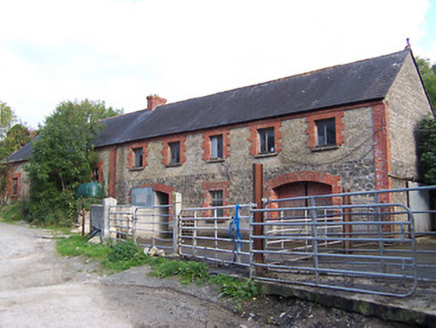Survey Data
Reg No
15402907
Rating
Regional
Categories of Special Interest
Architectural, Artistic, Historical
Original Use
Outbuilding
In Use As
Outbuilding
Date
1880 - 1900
Coordinates
210382, 239366
Date Recorded
10/10/2004
Date Updated
--/--/--
Description
Detached multi-bay two-storey outbuilding previously associated with Glynnwood House (demolished), built c.1890. Now in use as a farm building. Pitched natural slate roof with red clay ridge tiles, terracotta finials to gable ends, a red brick eaves course and a central moulded red brick chimneystack. Constructed of limestone rubble to ground floor with yellow brick walls to first floor having red brick bands to corners. Square-headed window openings with brick block-and-start surrounds and replacement windows. Segmental-headed carriage arches to ground floor having brick voussoirs over and brick block-and-start surrounds. Located to the north of the site of Glynnwood House and surrounded by complex of ruinous rubble stone outbuildings. Set back from road in extensive grounds to the east of Athlone.
Appraisal
A good quality late nineteenth-century outbuilding, which retains much of its early form and character. This structure is unusual in that it has rubble limestone walls to the ground floor and brick walling over, suggesting that it may be the partial rebuild of an existing structure. The juxtaposition between the yellow brick and the rubble stone walls with the red brick dressings and detailing, creates an interesting and attractive appearance. The extensive brick detailing has the same character as that found on a number of late nineteenth-century houses to the east side of Athlone Town, suggesting they had a common designer and/or builder. This outbuilding previously served Glynwood House to the south (demolished). Glynnwood House was a large three-storey mid nineteenth-century Italianate house built on the site of an earlier house. It was the home of the Longwood Family throughout the nineteenth century and was the home of a Major T M Montgomery when it was accidentally burnt down in 1918. This building now stands in a ruinous complex of early nineteenth-century rubble stone outbuildings, which contribute substantially to the setting, and acts as an historical reminder of this once great estate.

